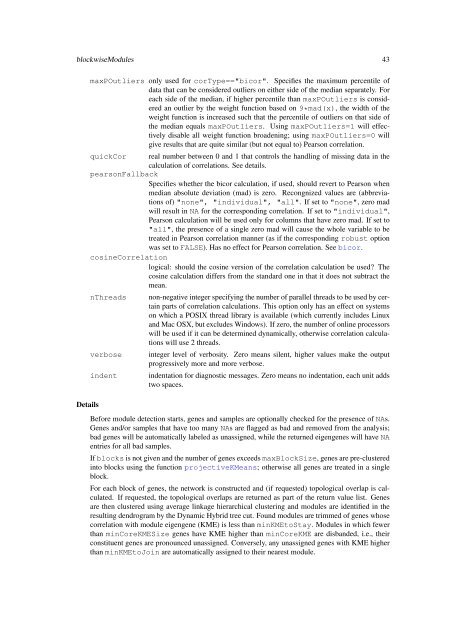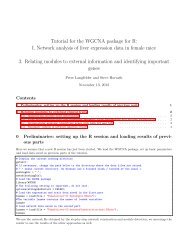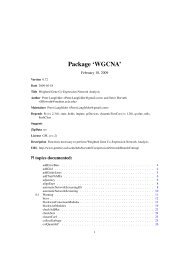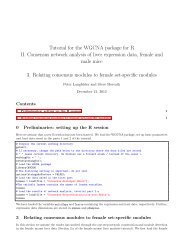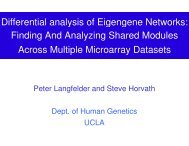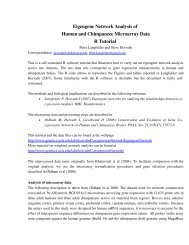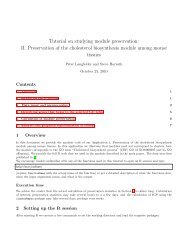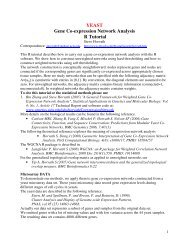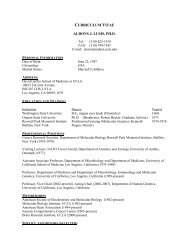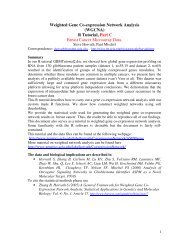Package 'WGCNA' - UCLA Human Genetics
Package 'WGCNA' - UCLA Human Genetics
Package 'WGCNA' - UCLA Human Genetics
You also want an ePaper? Increase the reach of your titles
YUMPU automatically turns print PDFs into web optimized ePapers that Google loves.
lockwiseModules 43maxPOutliers only used for corType=="bicor". Specifies the maximum percentile ofdata that can be considered outliers on either side of the median separately. Foreach side of the median, if higher percentile than maxPOutliers is consideredan outlier by the weight function based on 9*mad(x), the width of theweight function is increased such that the percentile of outliers on that side ofthe median equals maxPOutliers. Using maxPOutliers=1 will effectivelydisable all weight function broadening; using maxPOutliers=0 willgive results that are quite similar (but not equal to) Pearson correlation.quickCor real number between 0 and 1 that controls the handling of missing data in thecalculation of correlations. See details.pearsonFallbackSpecifies whether the bicor calculation, if used, should revert to Pearson whenmedian absolute deviation (mad) is zero. Recongnized values are (abbreviationsof) "none", "individual", "all". If set to "none", zero madwill result in NA for the corresponding correlation. If set to "individual",Pearson calculation will be used only for columns that have zero mad. If set to"all", the presence of a single zero mad will cause the whole variable to betreated in Pearson correlation manner (as if the corresponding robust optionwas set to FALSE). Has no effect for Pearson correlation. See bicor.cosineCorrelationlogical: should the cosine version of the correlation calculation be used? Thecosine calculation differs from the standard one in that it does not subtract themean.DetailsnThreadsverboseindentnon-negative integer specifying the number of parallel threads to be used by certainparts of correlation calculations. This option only has an effect on systemson which a POSIX thread library is available (which currently includes Linuxand Mac OSX, but excludes Windows). If zero, the number of online processorswill be used if it can be determined dynamically, otherwise correlation calculationswill use 2 threads.integer level of verbosity. Zero means silent, higher values make the outputprogressively more and more verbose.indentation for diagnostic messages. Zero means no indentation, each unit addstwo spaces.Before module detection starts, genes and samples are optionally checked for the presence of NAs.Genes and/or samples that have too many NAs are flagged as bad and removed from the analysis;bad genes will be automatically labeled as unassigned, while the returned eigengenes will have NAentries for all bad samples.If blocks is not given and the number of genes exceeds maxBlockSize, genes are pre-clusteredinto blocks using the function projectiveKMeans; otherwise all genes are treated in a singleblock.For each block of genes, the network is constructed and (if requested) topological overlap is calculated.If requested, the topological overlaps are returned as part of the return value list. Genesare then clustered using average linkage hierarchical clustering and modules are identified in theresulting dendrogram by the Dynamic Hybrid tree cut. Found modules are trimmed of genes whosecorrelation with module eigengene (KME) is less than minKMEtoStay. Modules in which fewerthan minCoreKMESize genes have KME higher than minCoreKME are disbanded, i.e., theirconstituent genes are pronounced unassigned. Conversely, any unassigned genes with KME higherthan minKMEtoJoin are automatically assigned to their nearest module.


